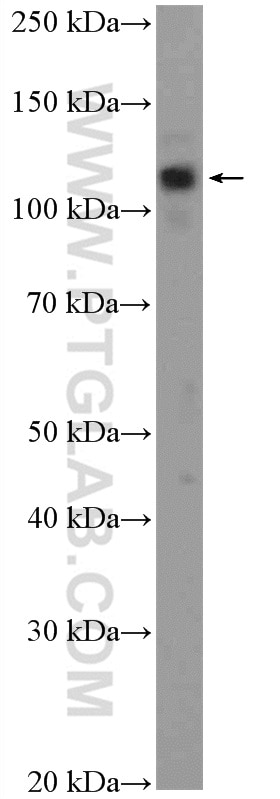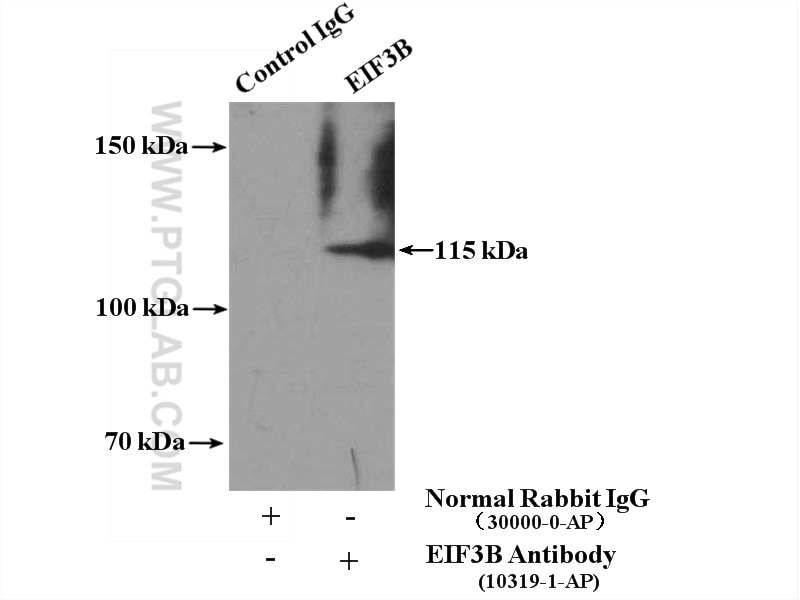Anticorps Polyclonal de lapin anti-EIF3B
EIF3B Polyclonal Antibody for WB, IP, ELISA
Hôte / Isotype
Lapin / IgG
Réactivité testée
Humain et plus (1)
Applications
WB, IF, IP, ELISA
Conjugaison
Non conjugué
N° de cat : 10319-1-AP
Synonymes
Galerie de données de validation
Applications testées
| Résultats positifs en WB | cellules A375 |
| Résultats positifs en IP | cellules A375 |
Dilution recommandée
| Application | Dilution |
|---|---|
| Western Blot (WB) | WB : 1:200-1:1000 |
| Immunoprécipitation (IP) | IP : 0.5-4.0 ug for 1.0-3.0 mg of total protein lysate |
| It is recommended that this reagent should be titrated in each testing system to obtain optimal results. | |
| Sample-dependent, check data in validation data gallery | |
Applications publiées
| WB | See 7 publications below |
| IF | See 2 publications below |
Informations sur le produit
10319-1-AP cible EIF3B dans les applications de WB, IF, IP, ELISA et montre une réactivité avec des échantillons Humain
| Réactivité | Humain |
| Réactivité citée | Humain, souris |
| Hôte / Isotype | Lapin / IgG |
| Clonalité | Polyclonal |
| Type | Anticorps |
| Immunogène | EIF3B Protéine recombinante Ag0386 |
| Nom complet | eukaryotic translation initiation factor 3, subunit B |
| Masse moléculaire calculée | 93 kDa |
| Poids moléculaire observé | 115 kDa |
| Numéro d’acquisition GenBank | BC001173 |
| Symbole du gène | EIF3B |
| Identification du gène (NCBI) | 8662 |
| Conjugaison | Non conjugué |
| Forme | Liquide |
| Méthode de purification | Purification par affinité contre l'antigène |
| Tampon de stockage | PBS with 0.02% sodium azide and 50% glycerol |
| Conditions de stockage | Stocker à -20°C. Stable pendant un an après l'expédition. L'aliquotage n'est pas nécessaire pour le stockage à -20oC Les 20ul contiennent 0,1% de BSA. |
Informations générales
EIF3B, also named as Eukaryotic translation initiation factor 3 subunit B, is a 814 amino acid protein, which contains 1 RRM (RNA recognition motif) domain and 8 WD repeats and belongs to the eIF-3 subunit B family. EIF3B as a RNA-binding component of the eukaryotic translation initiation factor 3 (eIF-3) complex, is required for several steps in the initiation of protein synthesis. The eIF-3 complex associates with the 40S ribosome and facilitates the recruitment of eIF-1, eIF-1A, eIF-2:GTP:methionyl-tRNAi and eIF-5 to form the 43S pre-initiation complex (43S PIC). The eIF-3 complex stimulates mRNA recruitment to the 43S PIC and scanning of the mRNA for AUG recognition. The eIF-3 complex is also required for disassembly and recycling of post-termination ribosomal complexes and subsequently prevents premature joining of the 40S and 60S ribosomal subunits prior to initiation. The eIF-3 complex specifically targets and initiates translation of a subset of mRNAs involved in cell proliferation, including cell cycling, differentiation and apoptosis, and uses different modes of RNA stem-loop binding to exert either translational activation or repression. The calculated molecular weight of EIF3B is 93 kDa, but the phosphorylated EIF3B protein is about 115 kDa.
Protocole
| Product Specific Protocols | |
|---|---|
| WB protocol for EIF3B antibody 10319-1-AP | Download protocol |
| IP protocol for EIF3B antibody 10319-1-AP | Download protocol |
| Standard Protocols | |
|---|---|
| Click here to view our Standard Protocols |
Publications
| Species | Application | Title |
|---|---|---|
Nucleic Acids Res SUMOylation of the m6A-RNA methyltransferase METTL3 modulates its function. | ||
Elife Translation initiation by the hepatitis C virus IRES requires eIF1A and ribosomal complex remodeling. | ||
Cancers (Basel) GDF15 Is an Eribulin Response Biomarker also Required for Survival of DTP Breast Cancer Cells. | ||
bioRxiv Novel gene-specific translation mechanism of dysregulated, chronic inflammation reveals promising, multifaceted COVID-19 therapeutics. | ||
Nat Commun METTL3 acetylation impedes cancer metastasis via fine-tuning its nuclear and cytosolic functions | ||
Cell Chem Biol Non-canonical function of histone methyltransferase G9a in the translational regulation of chronic inflammation |



